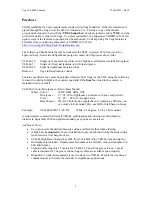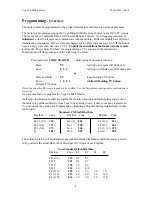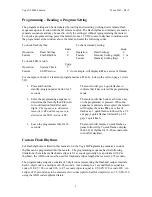
Vega VLB-44 Lantern
25 Jan 2011 - Rev 9
Servicing
Servicing should be performed in accordance with the standard cycle established for the aid.
Ensure that the lens is clean. Wipe with a cloth dampened with mild soap and water, if necessary.
Cover the window above the label to ensure that the lantern flashes on rhythm. Check to be sure
all LEDs are lit around the lantern. If more than 3 LEDs are out, it may create an area of reduced
intensity or no coverage in that region. Do not open the lantern on station. Parts are not captive
and will be easily lost. The lantern may still provide adequate service to the mariner, but a
replacement should be procured as soon as possible.
Inspect the wiring and power system in accordance with the Short Range Aids to Navigation
Servicing Guide. Replace, if necessary using the procedure listed below.
Power Cable Replacement
The power cable for the VLB-44 is wired to the circuit board inside the lantern through a stuffing
tube. Replacement cable should be 12/2 SOW, SOOW, SJOW, SJOOW for 3-8 tier lanterns and
16/2 for 1-2 tier lanterns (“S” is 600 V insulation, “SJ” is 300 volt insulation, “O” is oil
resistance, and “W” is for outdoor use). Jacket diameters should be approximately 0.385” for the
16/2 cable and 0.441” for the 12/2 cable. Note: the lantern is wired with 3 conductor cable. We
do not use the 3
rd
conductor for most applications, so 2 conductor wire may be purchased.
Sources are:
http://www.delcowireus.com/
,
www.mcmaster.com
, or any local supplier.
The ends of the wires terminating inside the lantern
must
be sealed as water will travel along the
strands and exit in the lantern. After stripping back the appropriate length of outer jacket and
conductor jacket, tin the ends of the wire with rosin core solder. Slide a ½” long piece of heat
shrink tube on each conductor and crimp and solder a non-insulated ring lug for a number 6 stud
(or M3 stud) onto each wire. After the terminations cool, slide the heat shrink tubing over the
shoulder of the lug and shrink so that the insulation and lug are sealed (see next page).
Open the lantern using a 2.5mm Allen wrench to remove 9 fasteners from the bottom of the base
including the three fasteners inside the center tube. Fasteners have a conical sealing washer on
them (they may stick to the lantern). Do not lose these washers.
Unscrew the old cable from the circuit board. Screws are metric, so do not lose them. Remove
the old cable by loosening the outer cap on the stuffing tube and pulling the cable from the
lantern. Slide the bushing (packing) off the old cable, inspect for tears and replace, if necessary.
Replace the stuffing tube, if necessary. 1-2 tier lanterns use a M16-1.5P stuffing tube and 3-8 tier
lanterns use a M20-1.5P stuffing tube. These have metric threads and are available from
http://www.lappusa.com/index.htm
, SKINTOP SLM/SLRM series plastic dome cable connector
part number S2509 and S2513, respectively.
Slide the stuffing tube cap and bushing on the new cable, feed it through the stuffing tube and
connect to the circuit board, as shown below. Be sure that the cable is tight in the stuffing tube
(give it a tug) to prevent water vapor from entering the lantern. Reassemble the lantern paying
careful attention to the two O- rings that seal the base to the optic head. Insert the 9 metric
fasteners with conical sealing washers and tighten in a crisscross pattern until they are snug. Do
not over tighten. Test the lantern before redeployment.
17


































